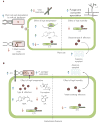Plant-Pathogen Warfare under Changing Climate Conditions
- PMID: 29787730
- PMCID: PMC5967643
- DOI: 10.1016/j.cub.2018.03.054
Plant-Pathogen Warfare under Changing Climate Conditions
Abstract
Global environmental changes caused by natural and human activities have accelerated in the past 200 years. The increase in greenhouse gases is predicted to continue to raise global temperature and change water availability in the 21st century. In this Review, we explore the profound effect the environment has on plant diseases - a susceptible host will not be infected by a virulent pathogen if the environmental conditions are not conducive for disease. The change in CO2 concentrations, temperature, and water availability can have positive, neutral, or negative effects on disease development, as each disease may respond differently to these variations. However, the concept of disease optima could potentially apply to all pathosystems. Plant resistance pathways, including pattern-triggered immunity to effector-triggered immunity, RNA interference, and defense hormone networks, are all affected by environmental factors. On the pathogen side, virulence mechanisms, such as the production of toxins and virulence proteins, as well as pathogen reproduction and survival are influenced by temperature and humidity. For practical reasons, most laboratory investigations into plant-pathogen interactions at the molecular level focus on well-established pathosystems and use a few static environmental conditions that capture only a fraction of the dynamic plant-pathogen-environment interactions that occur in nature. There is great need for future research to increasingly use dynamic environmental conditions in order to fully understand the multidimensional nature of plant-pathogen interactions and produce disease-resistant crop plants that are resilient to climate change.
Copyright © 2018 Elsevier Ltd. All rights reserved.
Conflict of interest statement
The authors declare no competing interests.
Figures


References
-
- Fry WE, Birch PR, Judelson HS, Grünwald NJ, Danies G, Everts KL, Gevens AJ, Gugino BK, Johnson DA, Johnson SB, et al. Five reasons to consider Phytophthora infestans a reemerging pathogen. Phytopathology. 2015;105:966–981. - PubMed
-
- Anagnostakis SL. Chestnut blight: The classical problem of an introduced pathogen. Mycologia. 1987;79:23–37.
-
- Oerke EC. Crop losses to pests. J Agric Sci. 2006;144:31–43.
-
- Savary S, Ficke A, Aubertot JN, Hollier C. Crop losses due to diseases and their implications for global food production losses and food security. Food Sec. 2012;4:519–537.
-
- Rybicki EP. A Top Ten list for economically important plant viruses. Arch Virol. 2015;160:17–20. - PubMed
Publication types
MeSH terms
Substances
Grants and funding
LinkOut - more resources
Full Text Sources
Other Literature Sources
Medical
Miscellaneous

